
The Battle of Büren 1759
11th August 2022, 0 Comments
The Seven Years War, Post of Honour, 28mm
This week we continued our try-out of Post of Honour, the free SYW rules from Keith Flint. As they’re very similar to Keith’s Napoleonic set Shadow of the Eagles which we use, then the learning curve” is pretty minimal. Still, there are a few differences, and we wanted to nail these down in our heads. In this little game, with just eight units a side, Sean played the French while I commanded the Western Allies. We used a 6×4 foot table, with fairly open terrain on it, apart from some small villages. We had evenly-matched forces, with four cavalry regiments and four infantry battalions a side, with one infantry and two cavalry brigadiers, and a Commander-in-Chief – Prinz Karl von Brunswick on my side, and the Compte de St. Germaine on the other.
In this little game, with just eight units a side, Sean played the French while I commanded the Western Allies. We used a 6×4 foot table, with fairly open terrain on it, apart from some small villages. We had evenly-matched forces, with four cavalry regiments and four infantry battalions a side, with one infantry and two cavalry brigadiers, and a Commander-in-Chief – Prinz Karl von Brunswick on my side, and the Compte de St. Germaine on the other. 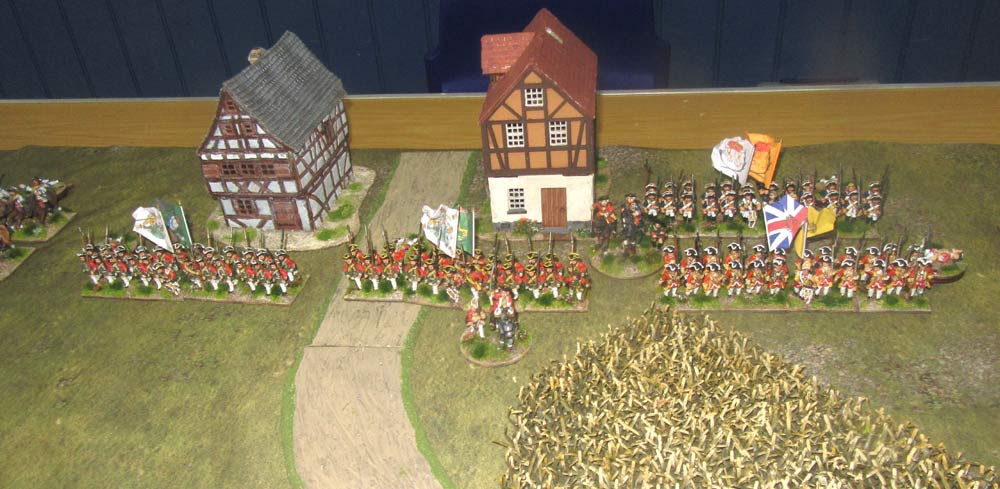 We began with a traditional advance of our infantry towards each other. The problem here is that you if you combine moving and shooting, you’re at a disadvantage for a turn. So, we were both wary about closing within musket range – at first. The cavalry though, were a lot less reticent, and I charged forward on both wings. This was pretty rash, but I was in that kind of mood that evening.
We began with a traditional advance of our infantry towards each other. The problem here is that you if you combine moving and shooting, you’re at a disadvantage for a turn. So, we were both wary about closing within musket range – at first. The cavalry though, were a lot less reticent, and I charged forward on both wings. This was pretty rash, but I was in that kind of mood that evening. 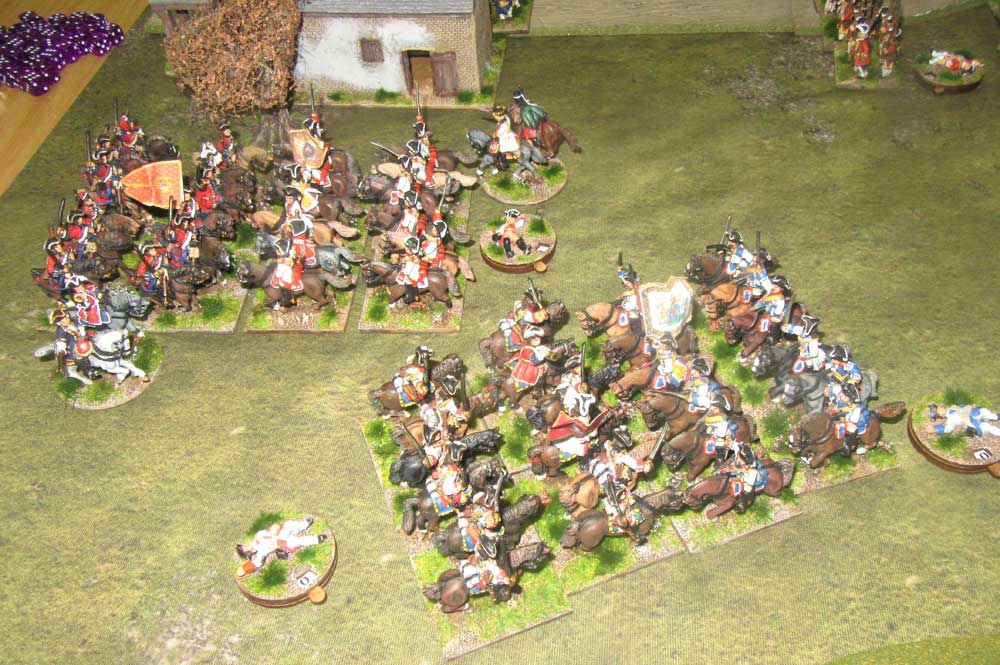 So, we had cavalry clashes on both wings. On the Allied left, my Hanovarian von Hodenburg regiment drove back the French La Reine dragoons, while half the Briedenbach dragoons and the French Chabrillant regiment both fought each other to a draw, and then retired to regroup. That’s the clash up above. The little casualty markers by the way, record “hits” – seven of those and you rout.
So, we had cavalry clashes on both wings. On the Allied left, my Hanovarian von Hodenburg regiment drove back the French La Reine dragoons, while half the Briedenbach dragoons and the French Chabrillant regiment both fought each other to a draw, and then retired to regroup. That’s the clash up above. The little casualty markers by the way, record “hits” – seven of those and you rout.  On the Allied right though, things didn’t go so well. I actually had a “Dashing” cavalry commander there, von Grothausen, and so had high hopes. He might have been dashing, but he wasn’t that lucky. The dice went against him, and both the von Reusch (“Black”) hussars and the rest of the Breidenbach dragoons were forced to retreat. Both units were now “worn”, which meant they’d suffered at least four hits.
On the Allied right though, things didn’t go so well. I actually had a “Dashing” cavalry commander there, von Grothausen, and so had high hopes. He might have been dashing, but he wasn’t that lucky. The dice went against him, and both the von Reusch (“Black”) hussars and the rest of the Breidenbach dragoons were forced to retreat. Both units were now “worn”, which meant they’d suffered at least four hits.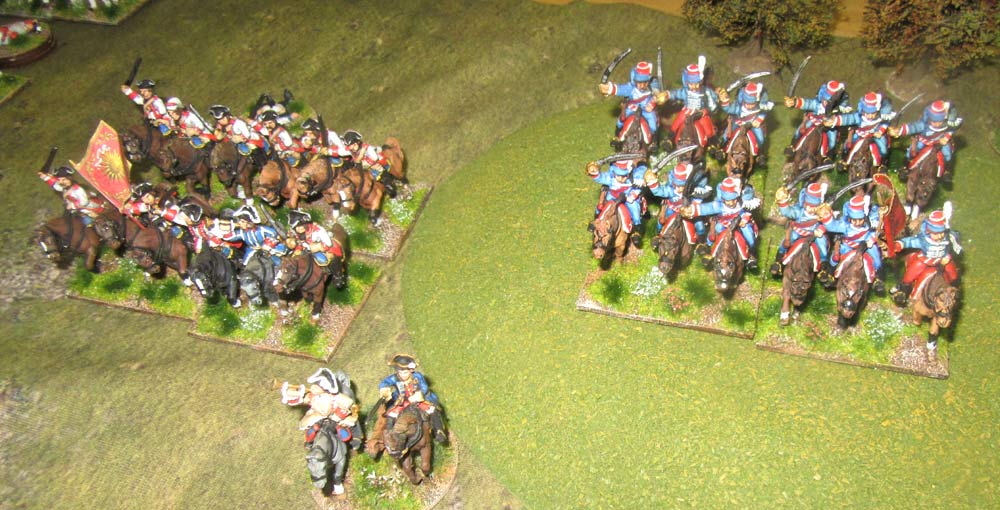 One of the French units facing them, the Bourbon-Busset cavalry regiment now had three hits, but the Brecheny hussars were still fairly fresh, and were up for a fight. They could both still charge though, and they did, routing my cavalry wing in a single turn. The “dashing” von Grothausen “dashed” off the field! That meant Sean could now turn his cavalry around and charge my infantry.
One of the French units facing them, the Bourbon-Busset cavalry regiment now had three hits, but the Brecheny hussars were still fairly fresh, and were up for a fight. They could both still charge though, and they did, routing my cavalry wing in a single turn. The “dashing” von Grothausen “dashed” off the field! That meant Sean could now turn his cavalry around and charge my infantry.  This, clearly, wasn’t good. However, on the other flank I’d routed the French dragoons, and with two regiments to one I then saw off the Chabrillant regiment. So, both Sean and I had won our cavalry battles on one wing. The problem was, the French infantry had their flank up against a village, I couldn’t get at them. That meant I either had to ride across the table to get at the victorious enemy cavalry, or I could charge through gaps in my infantry line if any of the French foot looked vulnerable enough to attack.
This, clearly, wasn’t good. However, on the other flank I’d routed the French dragoons, and with two regiments to one I then saw off the Chabrillant regiment. So, both Sean and I had won our cavalry battles on one wing. The problem was, the French infantry had their flank up against a village, I couldn’t get at them. That meant I either had to ride across the table to get at the victorious enemy cavalry, or I could charge through gaps in my infantry line if any of the French foot looked vulnerable enough to attack. 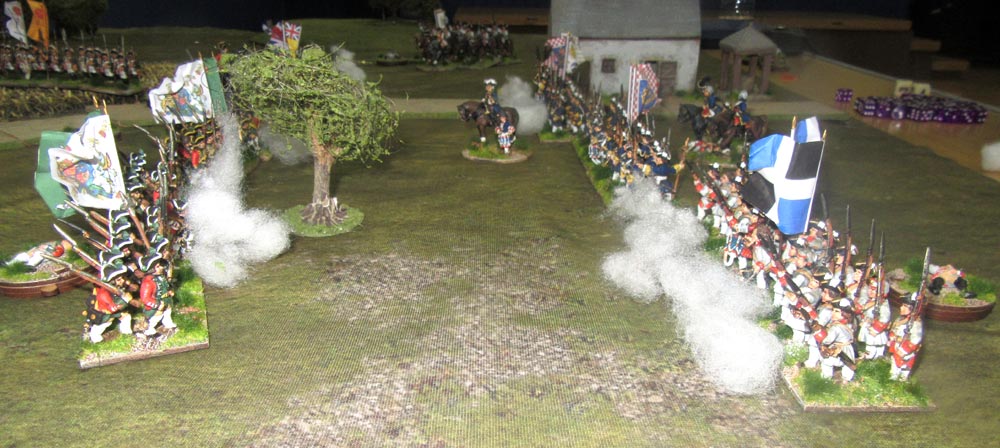 Meanwhile, in the centre I’d biitten the bullet and advanced into musket range. Actually I got off fairly lightly, and my own volley did better than I’d hoped. So, we set to, exchanging volleys at fairly close range. The French had a slight disadvantage as they were arrayed two battalions deep. So, while Sean extended his line, I shot at the French units who were standing still and firing back.
Meanwhile, in the centre I’d biitten the bullet and advanced into musket range. Actually I got off fairly lightly, and my own volley did better than I’d hoped. So, we set to, exchanging volleys at fairly close range. The French had a slight disadvantage as they were arrayed two battalions deep. So, while Sean extended his line, I shot at the French units who were standing still and firing back.  Eventually, two of his units became “worn”, and pulled back. I then concentrated my fire on the 2nd battalion of the Lyonnois Regiment and broke it. That was just as well, as those cavalry were now about to charge me in the rear. I turned around the Hanovarian Junge Zastrow regiment, and when the charge came, from the Bourbon-Busset regiment, the French horsemen were thrown back. His hussars though, were lining up for a flank attack, which didn’t bode well for my Hanovarians.
Eventually, two of his units became “worn”, and pulled back. I then concentrated my fire on the 2nd battalion of the Lyonnois Regiment and broke it. That was just as well, as those cavalry were now about to charge me in the rear. I turned around the Hanovarian Junge Zastrow regiment, and when the charge came, from the Bourbon-Busset regiment, the French horsemen were thrown back. His hussars though, were lining up for a flank attack, which didn’t bode well for my Hanovarians.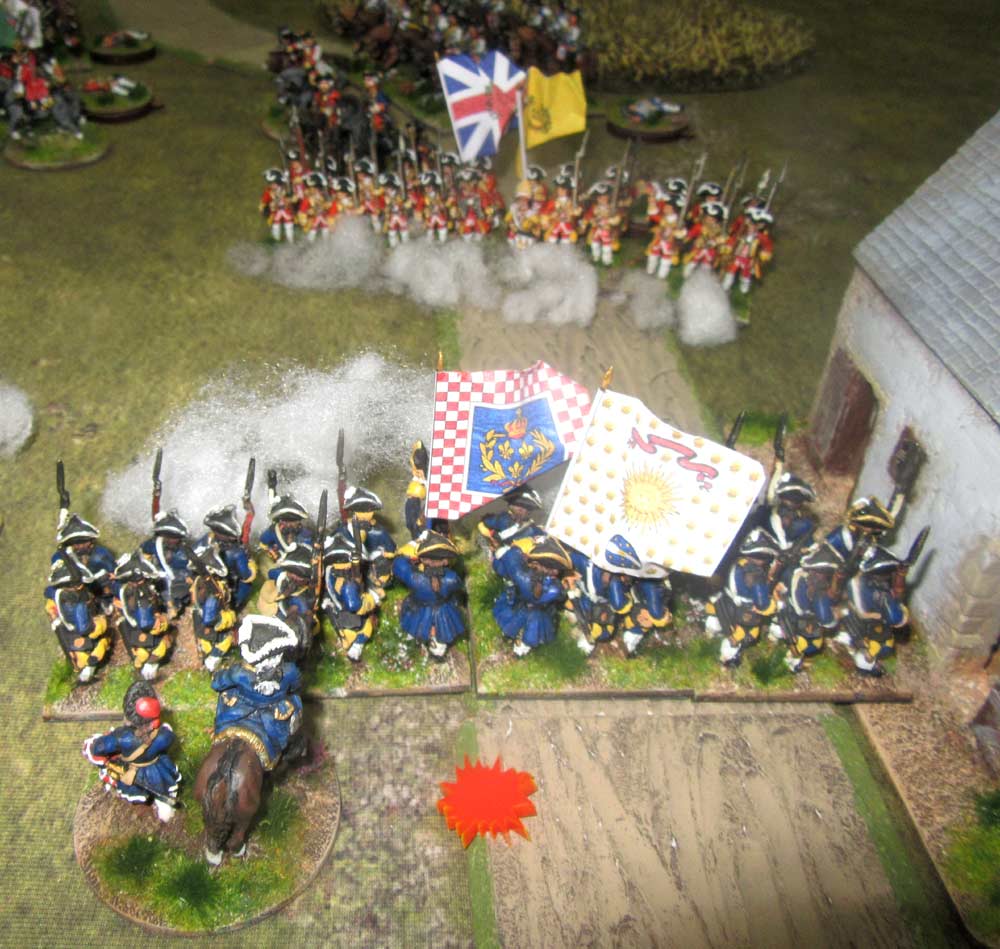 Over in the centre I’d peeled off a battalion of Hessian foot, and it was marching across the back of my infantry line to shore up my right flank. So too was my left flank cavalry, but they’d all get there too late to stop the Bercheny hussars from charging home. The only bright spot was that my British 20th Foot had finally driven back the La Mark Regiment – blue-coated Germans in French service – which evened the odds in the infantry fight. We were now two versus two, not counting the unit facing off the French cavalry.
Over in the centre I’d peeled off a battalion of Hessian foot, and it was marching across the back of my infantry line to shore up my right flank. So too was my left flank cavalry, but they’d all get there too late to stop the Bercheny hussars from charging home. The only bright spot was that my British 20th Foot had finally driven back the La Mark Regiment – blue-coated Germans in French service – which evened the odds in the infantry fight. We were now two versus two, not counting the unit facing off the French cavalry. 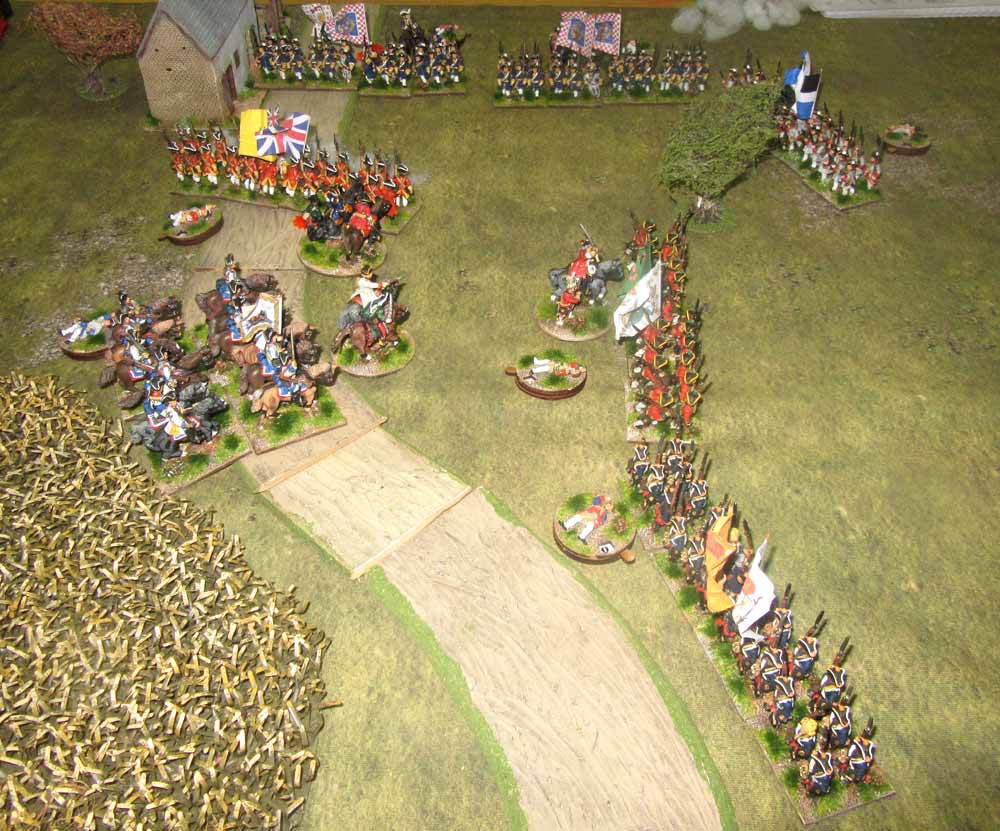 In the end it all came down to the Bercheny hussars and the Junge Zastrow infantry. The charge hit the Hanovarian infantry’s left flank, but in the rules you get a chance to react to charges. This time the dice gods came through, and I got to turn to face the chargers. Still, it was hit or miss affair, and could go either way. In the end though, Sean’s hussars became “worn” and had to retire.
In the end it all came down to the Bercheny hussars and the Junge Zastrow infantry. The charge hit the Hanovarian infantry’s left flank, but in the rules you get a chance to react to charges. This time the dice gods came through, and I got to turn to face the chargers. Still, it was hit or miss affair, and could go either way. In the end though, Sean’s hussars became “worn” and had to retire. 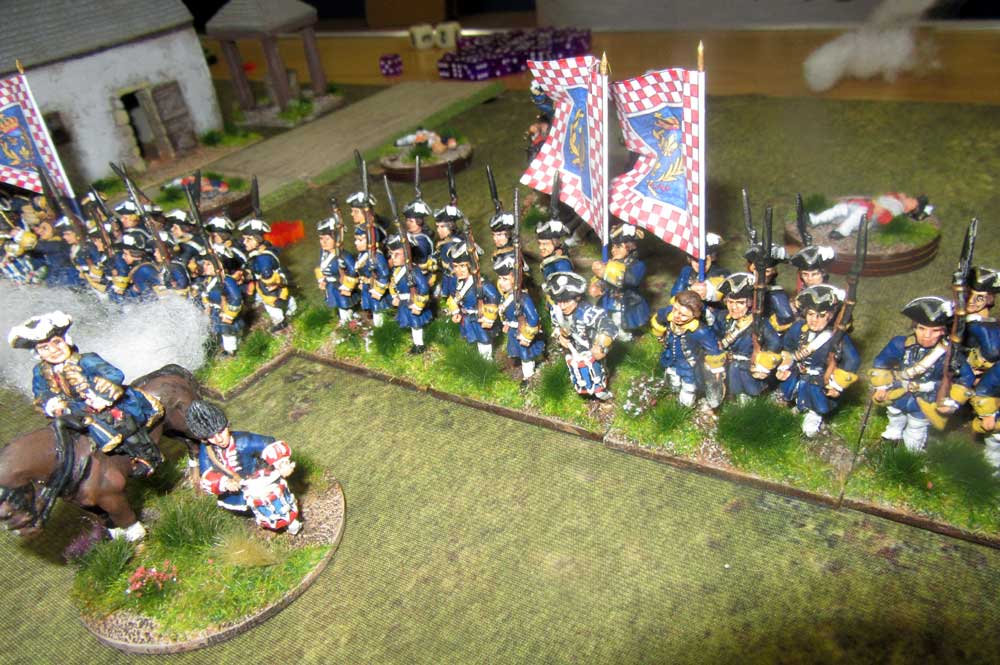 With that we decided to end the game. It had been a tough little fight, and great fun to play. We quite like the rules, which are slightly simpler than their Napoleonic version, and also less challenging that Keith Flint’s other SYW rules Honours of War, published by Osprey. What we might try next time though, is to tack on some rules and mechanisms from Honours of War, to give Post of Honour a little more depth. For a club night game though, they’re ideal – which is why we line Shadow of the Eagles too.
With that we decided to end the game. It had been a tough little fight, and great fun to play. We quite like the rules, which are slightly simpler than their Napoleonic version, and also less challenging that Keith Flint’s other SYW rules Honours of War, published by Osprey. What we might try next time though, is to tack on some rules and mechanisms from Honours of War, to give Post of Honour a little more depth. For a club night game though, they’re ideal – which is why we line Shadow of the Eagles too. 

